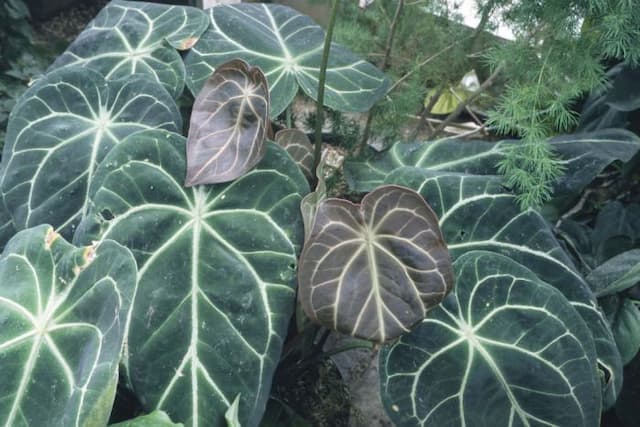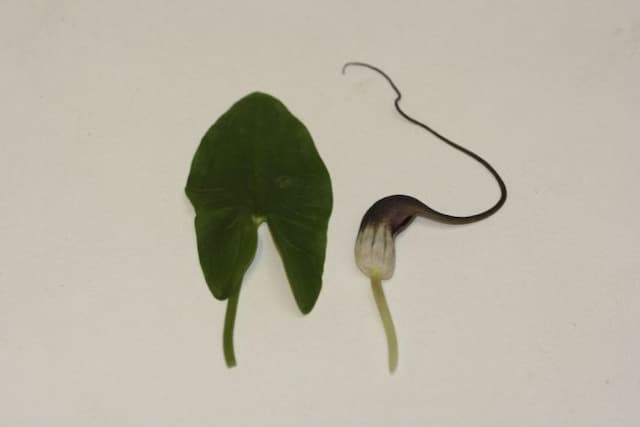Satin Pothos 'Argyraeus' Scindapsus pictus 'Argyraeus'

ABOUT
The plant commonly known as "Satin Pothos" is an attractive houseplant that is cherished for the unique appearance of its foliage. Its leaves are heart-shaped with a velvety texture and feature a striking green color with silvery and light green variegation. This variegation consists of spots and splotches that give the leaves a speckled or marbled look, reminiscent of satin fabric that shimmers in the light. The leaves of the Satin Pothos have a glossy and often slightly iridescent sheen to them, which enhances the visual appeal of the variegation. This foliage grows on trailing stems that tend to drape over the side of pots or can even climb if given support, making it a versatile option for interior decorating. The plant’s modest and elegant appearance makes it a popular choice for adding greenery to both homes and offices, bringing a touch of nature indoors with a sophisticated flair.
About this plant
 Names
NamesFamily
Araceae
Synonyms
Satin Pothos, Silver Vine, Silk Pothos, Silver Pothos, Silver Philodendron
Common names
Scindapsus pictus 'Argyraeus'.
 Toxicity
ToxicityTo humans
The plant commonly known as Satin Pothos is considered mildly toxic to humans. If ingested, it can cause irritation to the mouth, lips, tongue, and throat due to the presence of insoluble calcium oxalates. Symptoms may include a burning sensation, difficulty swallowing, and vomiting. In rare cases, swelling of the affected areas could potentially lead to difficulty breathing, although this is not common. It is advisable to keep the Satin Pothos out of reach of children who might accidentally ingest parts of the plant.
To pets
The Satin Pothos is toxic to pets, including cats and dogs, due to the presence of insoluble calcium oxalates. If a pet chews or ingests any part of the plant, it can experience symptoms such as oral irritation, intense burning and irritation of the mouth, tongue, and lips, excessive drooling, vomiting, and difficulty swallowing. In severe cases, ingestion can lead to swelling of the upper airway, making it difficult for the pet to breathe. Pet owners should keep the Satin Pothos out of reach and seek veterinary care if they suspect their pet has ingested any part of the plant.
 Characteristics
CharacteristicsLife cycle
Perennials
Foliage type
Evergreen
Color of leaves
Variegated
Height
3 feet (0.91 meters)
Spread
2 feet (0.61 meters)
Plant type
Climber
Hardiness zones
11
Native area
Southeast Asia
Benefits
 General Benefits
General Benefits- Easy to care for: The Satin Pothos is a low-maintenance plant, making it ideal for both beginners and experienced plant owners.
- Attractive foliage: Its heart-shaped leaves with a silvery sheen add aesthetic appeal to any indoor space.
- Versatile in placement: It can thrive in a range of lighting conditions from low to bright, indirect light.
- Great for hanging baskets: With its cascading vines, it's perfect for hanging baskets, adding a touch of greenery at eye level.
- Drought-tolerant: It is somewhat drought-tolerant, making it forgiving if occasionally under-watered.
- Growth pattern: The Satin Pothos exhibits a trailing growth habit, which can be attractive in various home decor settings.
- Room decoration: Its unique appearance provides an excellent decorative element to rooms without requiring too much space.
 Medical Properties
Medical PropertiesThis plant is not used for medical purposes.
 Air-purifying Qualities
Air-purifying QualitiesThis plant is not specifically known for air purifying qualities.
 Other Uses
Other Uses- Visual Aid in Education: Satin Pothos can be used in schools or educational programs as a living example to teach botany and plant biology, illustrating concepts like photosynthesis, climbing mechanisms and variegation in leaves.
- Photography Prop: Satin Pothos, with its striking leaves, can be a great addition to still-life photography or as a green backdrop to enhance the aesthetics of product photographs.
- Nature-Inspired Art: Artists may use Satin Pothos leaves as a model or inspiration for paintings, drawings, and other forms of art, capturing their unique patterns and shapes.
- Craft Material: The sturdy leaves and vines of Satin Pothos can be incorporated into crafts, such as making natural wreaths or as additions to mixed-media art pieces.
- Fashion Inspiration: The distinctive pattern of the leaves may inspire textile patterns in the fashion industry, for clothes, scarves, and other accessories.
- Botanical Jewelry: Preserved or dried leaves of Satin Pothos can be used to create unique pieces of jewelry like pendants and earrings.
- Culinary Decoration: Although not edible, the leaves can temporarily adorn presentation dishes in high-end culinary settings for their visual appeal, before being removed for consumption.
- Religious Symbolism: In some cultures, it might be used in religious ceremonies or kept in homes as symbols of prosperity and good fortune.
- Study of Climbing Plants: Satin Pothos can be used in scientific studies to better understand the mechanism of how some plants climb and adapt to their surroundings.
- Green Roofs and Walls: They can be incorporated into green roof systems or living walls for their aesthetic appeal and to enhance the diversity of plant species in urban landscaping projects.
Interesting Facts
 Feng Shui
Feng ShuiThe Silver Satin Pothos is not used in Feng Shui practice.
 Zodiac Sign Compitability
Zodiac Sign CompitabilityThe Silver Satin Pothos is not used in astrology practice.
 Plant Symbolism
Plant Symbolism- Resilience: The Scindapsus pictus 'Argyraeus', commonly known as the Satin Pothos, has a robust and hardy nature, representing one's ability to thrive despite challenges.
- Perseverance: As a plant that can adapt to lower light conditions, the Satin Pothos signifies the determination and perseverance to grow even in less than ideal circumstances.
- Growth: The vining habit of the Satin Pothos symbolizes continuous personal or spiritual growth and the pursuit of betterment.
- Adaptability: Known for its ability to tolerate a range of environments, this plant represents flexibility and the capacity to adjust to new situations.
 Water
WaterThe Satin Pothos should be watered when the top inch of soil feels dry to the touch, generally every 1 to 2 weeks, but the frequency can vary depending on environmental conditions such as light, temperature, and humidity. When watering, use room temperature water, and thoroughly soak the soil until water runs freely from the drainage holes. Allow all excess water to drain away, as this plant does not like to sit in water. It is better to under-water than over-water, as the plant is somewhat drought-tolerant. In terms of quantity, this might translate to approximately 8-16 ounces of water for a standard indoor pot, adjusting as necessary for your specific environment and pot size.
 Light
LightThe Satin Pothos thrives in medium to bright indirect light. It should be placed in a spot where it will receive dappled sunlight or a few hours of direct morning sun at most. Avoid strong direct afternoon sunlight, which can burn the leaves. An east-facing window is an excellent location for this plant, as it provides the gentle light it prefers.
 Temperature
TemperatureThe Satin Pothos fares best in temperatures between 65°F and 85°F, which are typical indoor temperatures. It can survive temporarily in temperatures as low as 50°F, but prolonged exposure to cold can damage the plant. Be sure to keep the Satin Pothos away from drafts, air conditioning units, and heating vents, which can create temperature fluctuations and stress the plant.
 Pruning
PruningPruning the Satin Pothos can encourage fuller growth and maintain the desired shape and size of the plant. Prune by snipping off leggy vines or any yellowing or damaged leaves. Pruning can be done as needed throughout the year, but it is best done during the spring or summer, which is the plant's active growing period. Use clean, sharp scissors or pruning shears to make clean cuts.
 Cleaning
CleaningAs needed
 Soil
SoilThe best soil mix for Satin Pothos is well-draining, aerated, and rich in organic matter. A mix of peat moss, perlite, and regular potting soil in equal parts works well. The ideal soil pH for Satin Pothos is between 6.1 to 6.5.
 Repotting
RepottingSatin Pothos should be repotted every 1-2 years or when it outgrows its pot. Early spring is the best time for repotting to allow for growth in the growing season.
 Humidity & Misting
Humidity & MistingSatin Pothos thrives in higher humidity levels, ideally between 60% to 80%. However, it can tolerate lower humidity levels found in most homes.
 Suitable locations
Suitable locationsIndoor
Place Satin Pothos in indirect light; water when soil is dry.
Outdoor
Grow Satin Pothos in shade; protect from cold and direct sun.
Hardiness zone
10-12 USDA
 Life cycle
Life cycleThe Scindapsus pictus 'Argyraeus', commonly known as the Satin Pothos, begins its life cycle when a seed germinates in a warm, humid environment, establishing roots and a primary shoot. As the plant enters its growth stage, it develops variegated heart-shaped leaves on trailing vines, benefitting from bright, indirect light. With proper care, the Satin Pothos will mature and produce more extensive leaf patterns and longer vines; it rarely flowers indoors but may produce inflorescences similar to those of other aroids if it does. Over time, the plant will require pruning to manage shape and size and to encourage fuller growth by promoting branching. If provided with a support, such as a moss pole, the Satin Pothos will climb, exhibiting more prominent leaf development due to the phenomenon of phenotypic plasticity. Eventually, when the plant reaches old age, growth will slow down, and without propagation through cuttings, the individual may decline and die, though its lifespan indoors can be many years with proper care.
 Propogation
PropogationPropogation time
Spring-Summer
The Scindapsus pictus 'Argyraeus', commonly known as the Silver Philodendron or Satin Pothos, can be propagated most effectively through stem cuttings, ideally taken during spring or early summer which is the plant's active growing season. To propagate the Satin Pothos, select a healthy stem with at least one node and a few leaves. Cut the stem just below a node using a clean, sharp pair of scissors or pruning shears. The node is where the roots will emerge, so it's important for the cutting to have at least one. Next, the cutting can be placed in water ensuring the node is submerged. Roots typically begin to grow within a few weeks; when they reach about an inch (approximately 2.5 centimeters) long, the new plant can be transferred to soil. This method maintains the variegation of the leaves and results in a high success rate for creating new, healthy plants.









